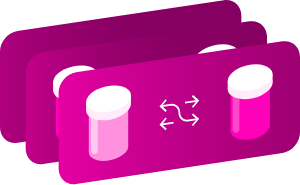Identification
- Summary
-
Gadoxetic acidis a gadolinium-based contrast agent used in magnetic resonance imaging (MRI) to help characterize lesions in the liver.
- Brand Names
-
Eovist, Primovist
- Generic Name
- Gadoxetic acid
- DrugBank Accession Number
- DB08884
- Background
-
Gadoxetic acid (gadoxetate) is a paramagnetic gadolinium-containing contrast agent in which its salt form, gadoxetate disodium, is used for intravenous injection. Ethoxybenzyl diethylenetriaminepentaacetic acid is the moiety that chelates with a gadolinium ion and forms a stable complex with it to make up the drug. It is marketed by Bayer HealthCare Pharmaceuticals and FDA approved on July 3, 2008.
- Type
- Small Molecule
- Groups
- Approved
- Structure
- Weight
-
Average: 681.75
Monoisotopic: 682.11214 - Chemical Formula
- C23H30GdN3O11
- Synonyms
-
- Gadoxetate
- Gadoxetic acid
- Gd-EOB-DTPA
Pharmacology
- Indication
-
Gadoxetate is used as a contrast medium for magnetic resonance imaging (MRI) to detect and characterize lesions in the liver.
 Reduce drug development failure ratesBuild, train, & validate machine-learning models
Reduce drug development failure ratesBuild, train, & validate machine-learning models
with evidence-based and structured datasets.Build, train, & validate predictive machine-learning models with structured datasets. - Associated Conditions
- Contraindications & Blackbox Warnings
-
 Avoid life-threatening adverse drug eventsImprove clinical decision support with information oncontraindications & blackbox warnings, population restrictions, harmful risks, & more.Avoid life-threatening adverse drug events & improve clinical decision support.
Avoid life-threatening adverse drug eventsImprove clinical decision support with information oncontraindications & blackbox warnings, population restrictions, harmful risks, & more.Avoid life-threatening adverse drug events & improve clinical decision support. - Pharmacodynamics
-
Gadoxetate二钠is an amphipathic compound in which gadoxetate is hydrophillic and its moiety, the ethoxybenyzl group, is lipophillic. Consequently, gadoxetate disodium has a biphasic mode of action in which it first distributes into the extracellular space after bolus injection and then hepatocytes selectively takes up the drug.
- Mechanism of action
-
When gadoxetate disodium is placed in an external magnetic field, a large magnetic moment is produced. As a result, a magnetic field is induced around the tissue. The water protons in the vicinity are disrupted such that the change the proton density and spin characteristics are detected and visualized by a device.
- 吸收
-
Not Available
- Volume of distribution
-
Total volume of distribution at steady state is 0.21 L/kg. Gadoxetate disodium cannot diffuse through the blood brain barrier. The two transporters that gadoxetate disodium can enter the hepatocyte through are OATP1B1 and OATP1B3. Gadoxetate disodium may also exit the heptaocyte and go back into sinusoidal space via active transport through multidrug resistance protein 3 and 4.
- Protein binding
-
<10% protein bound. Because it is more protein bound than other gadolinium-based contrast agents, gadoxetate disodium has increased T1 relaxivity. This results in an enhancement of the signal.
- Metabolism
-
Gadoxetate二钠is not metabolized.
- 路线的消除
-
Gadoxetate二钠is eliminated equally via urine and feces. Multidrug resistance protein 2 actively transports/excretes gadoxetate disodium into the bile.
- Half-life
-
Terminal elimination half-life, healthy subjects, adults = 0.91 - 0.95 hours
- Clearance
-
Clearance may be lower in older patients. Total serum clearance (CLtot) = 250 mL/min; Renal clearance (CLr) = 120 mL/min
- Adverse Effects
-
 Improve decision support & research outcomesWith structured adverse effects data, including:blackbox warnings, adverse reactions, warning & precautions, & incidence rates.Improve decision support & research outcomes with our structured adverse effects data.
Improve decision support & research outcomesWith structured adverse effects data, including:blackbox warnings, adverse reactions, warning & precautions, & incidence rates.Improve decision support & research outcomes with our structured adverse effects data. - Toxicity
-
LD50, oral, rat = 18100 mg/kg; LD50, oral, mouse = 14500 mg/kg; LD50, IV, rat = 3600 - 7300 mg/kg; LD50, IV, mouse = 5400 - 10900 mg/kg; LD50, IV, dog = >2200 mg/kg
- Pathways
- Not Available
- Pharmacogenomic Effects/ADRsBrowse all" title="" id="snp-actions-info" class="drug-info-popup" href="javascript:void(0);">
- Not Available
Interactions
- Drug InteractionsLearn More" title="" id="structured-interactions-info" class="drug-info-popup" href="javascript:void(0);">
-
This information should not be interpreted without the help of a healthcare provider. If you believe you are experiencing an interaction, contact a healthcare provider immediately. The absence of an interaction does not necessarily mean no interactions exist.
Drug Interaction Integrate drug-drug
interactions in your softwareAcetylcysteine The excretion of Gadoxetic acid can be decreased when combined with Acetylcysteine. Aminohippuric酸 The excretion of Gadoxetic acid can be decreased when combined with Aminohippuric acid. Amprenavir The excretion of Gadoxetic acid can be decreased when combined with Amprenavir. Apalutamide The serum concentration of Gadoxetic acid can be decreased when it is combined with Apalutamide. Asunaprevir The excretion of Gadoxetic acid can be decreased when combined with Asunaprevir. Ataluren The excretion of Gadoxetic acid can be decreased when combined with Ataluren. Atazanavir The excretion of Gadoxetic acid can be decreased when combined with Atazanavir. Atorvastatin The excretion of Gadoxetic acid can be decreased when combined with Atorvastatin. Axitinib The excretion of Gadoxetic acid can be decreased when combined with Axitinib. Beclomethasone dipropionate The excretion of Gadoxetic acid can be decreased when combined with Beclomethasone dipropionate.  Identify potential medication risksEasily compare up to 40 drugs with our drug interaction checker.Get severity rating, description, and management advice.Learn more
Identify potential medication risksEasily compare up to 40 drugs with our drug interaction checker.Get severity rating, description, and management advice.Learn more - Food Interactions
- No interactions found.
Products
-
 Drug product information from 10+ global regionsOur datasets provide approved product information including:
Drug product information from 10+ global regionsOur datasets provide approved product information including:
dosage, form, labeller, route of administration, and marketing period.Access drug product information from over 10 global regions. - Product Ingredients
-
Ingredient UNII CAS InChI Key Gadoxetate二钠 HOY74VZE0M 135326-22-6 SLYTULCOCGSBBJ-UHFFFAOYSA-I - Active Moieties
-
Name Kind UNII CAS InChI Key Gadolinium cation (3+) ionic AZV954TZ9N 22541-19-1 RJOJUSXNYCILHH-UHFFFAOYSA-N - Brand Name Prescription Products
-
Name Dosage Strength Route Labeller Marketing Start Marketing End Region Image Eovist Injection, solution 181.43 mg/1mL Intravenous Bayer HealthCare Pharmaceuticals Inc. 2008-07-03 Not applicable US Primovist Solution 181.43 mg / mL Intravenous Bayer 2010-02-04 Not applicable Canada
Categories
- ATC Codes
- V08CA10 — Gadoxetic acid
- Drug Categories
-
- Acetates
- Acids, Acyclic
- Amines
- Compounds used in a research, industrial, or household setting
- Contrast Media
- Coordination Complexes
- Diagnostic Uses of Chemicals
- Gadolinium-based Contrast Agent
- Magnetic Resonance Contrast Activity
- Magnetic Resonance Imaging Contrast Media
- OATP1B1/SLCO1B1 Substrates
- OATP1B3 substrates
- Other Diagnostics
- Paramagnetic Contrast Agent
- Paramagnetic Contrast Media
- Polyamines
- Classification
- Not classified
- Affected organisms
-
- Humans and other mammals
Chemical Identifiers
- UNII
- 3QJA87N40S
- CAS number
- 135326-11-3
- InChI Key
- PCZHWPSNPWAQNF-LMOVPXPDSA-K
- InChI
-
InChI=1S/C23H33N3O11.Gd/c1-2-37-18-5-3-16(4-6-18)9-17(26(14-22(33)34)15-23(35)36)10-24(11-19(27)28)7-8-25(12-20(29)30)13-21(31)32;/h3-6,17H,2,7-15H2,1H3,(H,27,28)(H,29,30)(H,31,32)(H,33,34)(H,35,36);/q;+3/p-3/t17-;/m0./s1
- IUPAC Name
-
gadolinium(3+) ion 2-[(2-{[(2S)-2-[bis(carboxymethyl)amino]-3-(4-ethoxyphenyl)propyl](carboxylatomethyl)amino}ethyl)(carboxylatomethyl)amino]acetate
- SMILES
-
[Gd+3].[H][C@@](CN(CCN(CC([O-])=O)CC([O-])=O)CC([O-])=O)(CC1=CC=C(OCC)C=C1)N(CC(O)=O)CC(O)=O
References
- General References
-
- Van Beers BE, Pastor CM, Hussain HK: Primovist, Eovist: what to expect? J Hepatol. 2012 Aug;57(2):421-9. doi: 10.1016/j.jhep.2012.01.031. Epub 2012 Apr 12. [Article]
- External Links
-
- KEGG Drug
- D04288
- PubChem Compound
- 131704314
- PubChem Substance
- 175427133
- ChemSpider
- 189907
- 802624
- ChEMBL
- CHEMBL1201768
- PharmGKB
- PA165985534
- RxList
- RxList Drug Page
- Drugs.com
- Drugs.com Drug Page
- Wikipedia
- Gadoxetic_acid
- FDA label
-
Download (223 KB)
- MSDS
-
Download (114 KB)
Clinical Trials
- Clinical TrialsLearn More" title="" id="clinical-trials-info" class="drug-info-popup" href="javascript:void(0);">
-
Phase Status Purpose Conditions Count 4 Completed Diagnostic Cirrhosis of the Liver 1 4 Completed Diagnostic 对比剂 1 4 Completed Diagnostic Hepatocellular Carcinoma 1 4 Completed Diagnostic Transient Severe Arterial Phase Motion 1 4 Recruiting Diagnostic Colorectal Cancer/Metastatic Cancer to Liver/Oligometastatic Disease 1 4 Recruiting Other Cognitive Functioning/对比剂/Motor Function 1 4 Withdrawn Treatment Metastatic Cancer to Liver/Primary Liver Cancer 1 3 Completed Diagnostic Known or Suspected Focal Liver Lesions 1 3 Terminated Diagnostic Magnetic Resonance Imaging (MRI) 1 2 Completed Diagnostic Prostate Cancer 1
Pharmacoeconomics
- Manufacturers
-
Not Available
- Packagers
-
Not Available
- Dosage Forms
-
Form Route Strength Injection, solution Intravenous 181.43 mg/1mL Injection Injection, solution Solution Intravenous 181.43 mg / mL Injection, solution Intravenous 0.25 mmol Injection, solution Parenteral Injection, solution Intravenous 181.43 mg Injection, solution Intravenous bolus 0.25 mmol/mL Solution Intravenous 0.25 mmol Solution Intravenous 181.43 mg/1ml - Prices
- Not Available
- Patents
-
Patent Number Pediatric Extension Approved Expires (estimated) Region US6039931 No 2000-03-21 2021-11-13 US US5798092 No 1998-08-25 2015-08-25 US
Properties
- State
- Solid
- Experimental Properties
-
Property Value Source pKa 6.8-8 MSDS - Predicted Properties
-
Property Value Source Water Solubility 0.497 mg/mL ALOGPS logP 1.24 ALOGPS logP -4.3 Chemaxon logS -3.2 ALOGPS pKa (Strongest Acidic) 1.98 Chemaxon pKa (Strongest Basic) 9.99 Chemaxon Physiological Charge -3 Chemaxon Hydrogen Acceptor Count 14 Chemaxon Hydrogen Donor Count 2 Chemaxon Polar Surface Area 213.94 Å2 Chemaxon Rotatable Bond Count 20 Chemaxon Refractivity 159.21 m3·mol-1 Chemaxon Polarizability 50.67 Å3 Chemaxon Number of Rings 1 Chemaxon Bioavailability 0 Chemaxon Rule of Five No Chemaxon Ghose Filter No Chemaxon Veber's Rule No Chemaxon MDDR-like Rule No Chemaxon - Predicted ADMET Features
-
Property Value Probability Human Intestinal Absorption + 0.6058 Blood Brain Barrier + 0.6251 Caco-2 permeable - 0.5137 P-glycoprotein substrate Substrate 0.6927 P-glycoprotein inhibitor I Non-inhibitor 0.6538 P-glycoprotein inhibitor II Non-inhibitor 0.9495 Renal organic cation transporter Non-inhibitor 0.6488 CYP450 2C9 substrate Non-substrate 0.8375 CYP450 2D6 substrate Non-substrate 0.8177 CYP450 3A4 substrate Non-substrate 0.6054 CYP450 1A2 substrate Non-inhibitor 0.6386 CYP450 2C9 inhibitor Non-inhibitor 0.7982 CYP450 2D6 inhibitor Non-inhibitor 0.6855 CYP450 2C19 inhibitor Non-inhibitor 0.781 CYP450 3A4 inhibitor Non-inhibitor 0.9528 CYP450 inhibitory promiscuity Low CYP Inhibitory Promiscuity 0.7762 Ames test Non AMES toxic 0.6871 Carcinogenicity Non-carcinogens 0.8385 Biodegradation Not ready biodegradable 0.6465 Rat acute toxicity 2.2477 LD50, mol/kg Not applicable hERG inhibition (predictor I) Weak inhibitor 0.5 hERG inhibition (predictor II) Non-inhibitor 0.7809
Spectra
- Mass Spec (NIST)
- Not Available
- Spectra
- Not Available
Transporters
- Kind
- Protein
- Organism
- Humans
- Pharmacological action
-
Unknown
- Actions
-
Substrate
- General Function
- Sodium-independent organic anion transmembrane transporter activity
- Specific Function
- Mediates the Na(+)-independent uptake of organic anions such as pravastatin, taurocholate, methotrexate, dehydroepiandrosterone sulfate, 17-beta-glucuronosyl estradiol, estrone sulfate, prostagland...
- Gene Name
- SLCO1B1
- Uniprot ID
- Q9Y6L6
- Uniprot Name
- Solute carrier organic anion transporter family member 1B1
- 分子量
- 76447.99 Da
References
- Nassif A, Jia J, Keiser M, Oswald S, Modess C, Nagel S, Weitschies W, Hosten N, Siegmund W, Kuhn JP: Visualization of hepatic uptake transporter function in healthy subjects by using gadoxetic acid-enhanced MR imaging. Radiology. 2012 Sep;264(3):741-50. doi: 10.1148/radiol.12112061. Epub 2012 Jul 6. [Article]
- Kind
- Protein
- Organism
- Humans
- Pharmacological action
-
Unknown
- Actions
-
Substrate
- General Function
- Sodium-independent organic anion transmembrane transporter activity
- Specific Function
- Mediates the Na(+)-independent uptake of organic anions such as 17-beta-glucuronosyl estradiol, taurocholate, triiodothyronine (T3), leukotriene C4, dehydroepiandrosterone sulfate (DHEAS), methotre...
- Gene Name
- SLCO1B3
- Uniprot ID
- Q9NPD5
- Uniprot Name
- Solute carrier organic anion transporter family member 1B3
- 分子量
- 77402.175哒
References
- Nassif A, Jia J, Keiser M, Oswald S, Modess C, Nagel S, Weitschies W, Hosten N, Siegmund W, Kuhn JP: Visualization of hepatic uptake transporter function in healthy subjects by using gadoxetic acid-enhanced MR imaging. Radiology. 2012 Sep;264(3):741-50. doi: 10.1148/radiol.12112061. Epub 2012 Jul 6. [Article]
- Kind
- Protein
- Organism
- Humans
- Pharmacological action
-
Unknown
- Actions
-
Substrate
- General Function
- Organic anion transmembrane transporter activity
- Specific Function
- May act as an inducible transporter in the biliary and intestinal excretion of organic anions. Acts as an alternative route for the export of bile acids and glucuronides from cholestatic hepatocyte...
- Gene Name
- ABCC3
- Uniprot ID
- O15438
- Uniprot Name
- Canalicular multispecific organic anion transporter 2
- 分子量
- 169341.14 Da
References
- Van Beers BE, Pastor CM, Hussain HK: Primovist, Eovist: what to expect? J Hepatol. 2012 Aug;57(2):421-9. doi: 10.1016/j.jhep.2012.01.031. Epub 2012 Apr 12. [Article]
- Kind
- Protein
- Organism
- Humans
- Pharmacological action
-
Unknown
- Actions
-
Substrate
- General Function
- Organic anion transmembrane transporter activity
- Specific Function
- Mediates hepatobiliary excretion of numerous organic anions. May function as a cellular cisplatin transporter.
- Gene Name
- ABCC2
- Uniprot ID
- Q92887
- Uniprot Name
- Canalicular multispecific organic anion transporter 1
- 分子量
- 174205.64 Da
References
- Van Beers BE, Pastor CM, Hussain HK: Primovist, Eovist: what to expect? J Hepatol. 2012 Aug;57(2):421-9. doi: 10.1016/j.jhep.2012.01.031. Epub 2012 Apr 12. [Article]
- Kind
- Protein
- Organism
- Humans
- Pharmacological action
-
Unknown
- Actions
-
Substrate
- General Function
- Atpase activity, coupled to transmembrane movement of substances
- Specific Function
- May be an organic anion pump relevant to cellular detoxification.
- Gene Name
- ABCC4
- Uniprot ID
- O15439
- Uniprot Name
- Multidrug resistance-associated protein 4
- 分子量
- 149525.33 Da
References
- Van Beers BE, Pastor CM, Hussain HK: Primovist, Eovist: what to expect? J Hepatol. 2012 Aug;57(2):421-9. doi: 10.1016/j.jhep.2012.01.031. Epub 2012 Apr 12. [Article]
Drug created at May 22, 2013 21:49 / Updated at April 15, 2023 12:42




